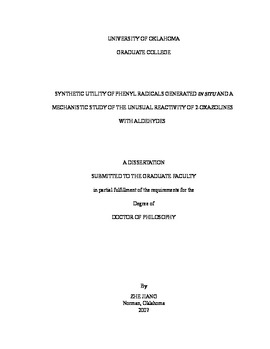| dc.contributor.advisor | Glatzhofer, Daniel, | en_US |
| dc.contributor.author | Jiang, Zhe. | en_US |
| dc.date.accessioned | 2013-08-16T12:21:03Z | |
| dc.date.available | 2013-08-16T12:21:03Z | |
| dc.date.issued | 2007 | en_US |
| dc.identifier.uri | https://hdl.handle.net/11244/1318 | |
| dc.description.abstract | There are few references to this unusual reaction in the literature and no mechanistic studies. Therefore, a mechanistic study has been carried in order to provide a better understanding of the reaction. These studies revealed that the reaction is catalyzed by acid. Hammett and Bronsted correlation studies on acids indicate alpha=0.74 and rho=0.93 while Hammett correlation studies on aldehydes indicate rho=0.71, suggesting an acid pre-equilibrium. Thermodynamic studies have shown DeltaH≠ = 3.5 kcal/mol and DeltaS ≠ = -70 cal/mol.K suggesting a concerted transition state including aldehydes, acid (benzoic acid or oxazolinium) and oxazoline. The rate determining step is believed to be an nucleophilic attack from the 2-oxazoline to the carbonyl group during the proton transfer process in the acid equilibrium. The results of all studies are summarized and a putative mechanism is presented which has some similarity to enzymatic reactions. Attempts to carry out metal-free Aldol reactions based on these reactions, along with other studies of the potential synthetic utility of the imine ester products, are also discussed in this dissertation. | en_US |
| dc.description.abstract | 2-Oxazolines, as typical cyclic imino ethers (CIEs), have a broad range of applications in organic synthesis as well as polymer chemistry. When 2-oxazolines react with compounds that can be considered as electrophile/nucleophile pairs, the electrophile will first be attacked by the nitrogen in 2-oxazolines, followed by the attack on the 5-position on the oxazoline by the nucleophile. However, reactions of 2-oxazolines with aldehydes are unusual in that 2-oxazolines react with aldehydes (R'CH=O) without alpha enolizable hydrogens to give imine esters of ethanolamine (R'CH=NCH2CH2O2CR). Ketones are observed to react much more slowly with 2-oxazolines compared to aldehydes. | en_US |
| dc.description.abstract | Phenyl radicals are very reactive intermediates in organic chemistry but there is not a large body of literature on the subject. It has been discovered in our research group that such radicals could be generated in a mild way from the decomposition of nitrosamides generated in situ from aromatic amides using sodium nitrite in 2:1 acetic anhydride and acetic acid. The phenyl radicals generated in situ can participate in various reactions including coupling reactions which occur in reactive aromatic solvents (such as benzene) to form biphenyl products in up to 80% yield, which is comparable to yields from of Suzuki Couplings. | en_US |
| dc.format.extent | ix, 142 leaves : | en_US |
| dc.subject | Oxazoles. | en_US |
| dc.subject | Chemistry, Organic. | en_US |
| dc.subject | Aldehydes Reactivity. | en_US |
| dc.subject | Radicals (Chemistry) | en_US |
| dc.subject | Phenyl compounds. | en_US |
| dc.title | Synthetic utility of phenyl radicals generated in situ and a mechanistic study of the unusual reactivity of 2-oxazolines with aldehydes. | en_US |
| dc.type | Thesis | en_US |
| dc.thesis.degree | Ph.D. | en_US |
| dc.thesis.degreeDiscipline | Department of Chemistry and Biochemistry | en_US |
| dc.note | Adviser: Daniel Glatzhofer. | en_US |
| dc.note | Source: Dissertation Abstracts International, Volume: 69-03, Section: B, page: 1651. | en_US |
| ou.identifier | (UMI)AAI3304579 | en_US |
| ou.group | College of Arts and Sciences::Department of Chemistry and Biochemistry | |
